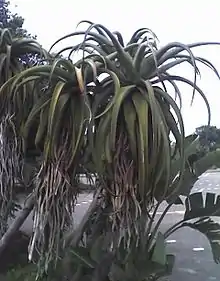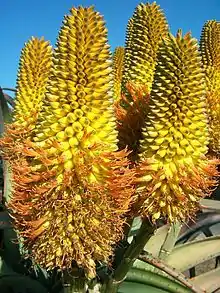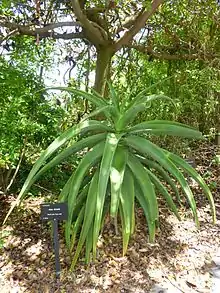| Aloe thraskii | |
|---|---|
 | |
| Scientific classification | |
| Kingdom: | Plantae |
| Clade: | Tracheophytes |
| Clade: | Angiosperms |
| Clade: | Monocots |
| Order: | Asparagales |
| Family: | Asphodelaceae |
| Subfamily: | Asphodeloideae |
| Genus: | Aloe |
| Species: | A. thraskii |
| Binomial name | |
| Aloe thraskii | |
Aloe thraskii, the dune aloe, is a South African plant in the genus Aloe.
Description

The orange-yellow flowers, growing on the typically compact, cylindrical racemes

Young plant in cultivation
The dune aloe is a tall, fast-growing, un-branched aloe, which develops a very large rosette. The long, pale, grey-green leaves are deeply grooved or channeled (U-shaped in cross-section) and recurve downwards.
The orange and yellow flowers grow in short, compact, cylindrical racemes, on multi-branched inflorescences.[2]
Distribution
These plants are naturally found in dune vegetation along the coast of KwaZulu-Natal and the Eastern Cape of South Africa.[3]
See also
References
Wikimedia Commons has media related to Aloe thraskii.
- ↑ Species was first described and published in Journal of the Linnean Society. Botany. 18: 180. 1880. London. "Plant Name Details for Aloe thraskii". IPNI. Retrieved August 6, 2010.
- ↑ "Introduction to Tree Aloes, part 1: the solitary, unbranched species - Dave's Garden". davesgarden.com. Retrieved 2017-08-01.
- ↑ Pooley, E. (1993). The Complete Field Guide to Trees of Natal, Zululand and Transkei. ISBN 0-620-17697-0.
This article is issued from Wikipedia. The text is licensed under Creative Commons - Attribution - Sharealike. Additional terms may apply for the media files.